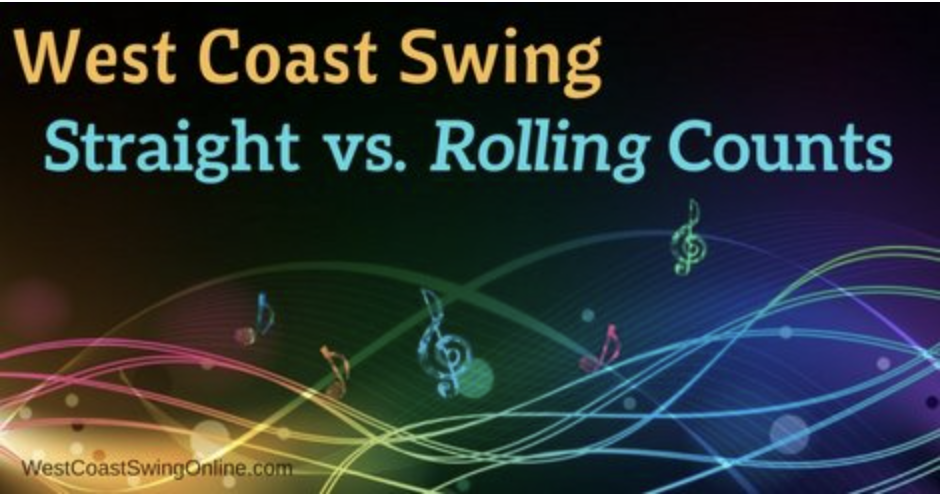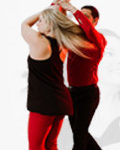Are you wondering what is rolling count in west coast swing? Rolling Count, turns out to be NOT a new concept. lt is simply an identification of a skill that has long been known, but not identified. Most top professional dancers eventually dance Rolling Count as a natural progression – that is simply identified as “Body Flight”. Some people spend years learning “Body Flight”. Learning Rolling Count develops this skill effortlessly in weeks, instead of years. One of the key moments in the growth for WCS dancers is when they realize that the &a count is at least as important as the beats of the dance. The &a is the key to dancing through the beat and not merely marching on the beat.
Watch our video on Rolling Count for West Coast Swing
Rolling count as it relates to dancing
Moving through the music with your body
Musical notes are not instantaneous events. Every note has an attack, a duration, and a release. When beginners dance, they don’t yet have the body control to replicate all three elements. As a result, they arrive on the beat and stop, waiting until the next beat. The entirety of their dance is attack, and it feels choppy. In dance, the way we move beyond choppy movements is by paying as much attention to what happens between the beats: the &a counts. In WCS, we begin teaching dancing through the beat through rolling. We use both rolling count (counting the music &a1&a2 to emphasize the flow into the beat) and rolling through the feet (so that the body’s movement continues after the attack).
Why should you care?
Good dancing is matching movement through space to movement through time. The best west coast swing dancers are those who fill the space in the music with movement in perfect harmony. This is dancing through the beat: continuing the motion to fill space and time with movement, not just ‘on the beat.’ The better you get at filling the entirety of the time with your movement through space, the better your dancing will look and feel. At higher levels, rolling through the feet is but one way to create fluidity. The movement of the center, arms, hips, feet, and even head can show the duration and release of the movement. These elements allow movements to blend into each other. When they are applied through the connection, they create the elasticity of the dance.
Skippy Blair is the key resource for rolling count. You can find her lots of great articles on her site. Or head to our Skippy Blair Series to hear about rolling count in Skippy’s words.
Rolling count as it relates to music
Straight vs. Rolling Counts
In west coast swing, there are three common ways to count music: straight count, rolling count, and swung count. This post will discuss straight vs. rolling counts; a follow-up post will take up the differences between rolling and swung counts.
Let’s break them down…At a basic level, music is divided into beats. If you just marched through the song, you would be moving exactly on the beat.
Many partner dances only move on the beat, at least in their basic patterns. A basic foxtrot—slow, slow, quick, quick—moves on the 1, 3, 5, and 6. Salsa moves on 1, 2, and 3, holding the 4 (hence the quick, quick, slow rhythm). Tango’s basic rhythm is slow, slow, quick, quick, slow, which translates to 1, 3, 5, 6, 7 if you’re counting in 4/4 time.
The swing family of dances (and a couple of other dances, like hustle and zouk) move between the beats. That’s why we count a side pass as 1, 2, 3 & 4, 5 & 6. The “and” counts occur somewhere between the beats. The difference between straight count, rolling count, and swung count is where the & is put between the beats.
Straight Count
The easiest way to divide the beat is to put the “and” directly in the middle of the beat. In straight count, the time between downbeat and & is the same as the time between & and the upbeat. As a result, most club music played for WCS should be counted in straight time. Examples of straight count songs include I Gotta Feeling by the Black Eyed Peas, Tik Tok by Ke$ha, and Blackout by Breathe Carolina.
Because most music on the radio is in straight time, beginners tend to dance straight count by default. It works out pretty well because a lot of the music played at west coast dances is now in straight time. But, dancing in straight time can look mechanical because everything is so evenly spaced. To help dancers become smoother, we need to talk about…
Rolling Count
The idea behind the rolling count is to break the beat up in a slightly off-center way. If straight time has one division between the beats, at the halfway mark, rolling count puts in two divisions: one at the 1/3 mark and one at the 2/3 mark. In swing, we follow the lead of the blues musicians who introduced this method of breaking up the beat by counting the divisions as “&” and “a.”
So, a rolling count for our side pass would be &a1 &a2 &a3 &a4 &a5 &a6 (with the bold and underlined elements being where the weight transfers happen).
There’s a lot going on with the rolling count, but for now I want to focus on two changes between straight count and rolling count. First, even though both of them use the same word—”&”—the &s are in different places within the beat. The straight count & is exactly halfway between the beats, whereas the rolling count & is closer to the first beat of the pair. In conclusion, the goal of rolling count is to divide the beat up into uneven pieces so that the dance looks less like marching; as a result, the & moves earlier in time.
Second, because the & is earlier in time, the rolling count rhythm doesn’t actually dance on &. Instead, it dances on the “a,” which is later than the & of straight count (the 2/3 mark, rather than halfway). Therefore, the reason we dance on the “a” will be the subject of a future post; the short answer is that dancing early feels tense and does weird things to the pulse of the dance, while dancing later creates a groovier feel and better sets up the pulse on the beat.
Examples of rolling count songs include I Got the Blues by Brother Yusef and Blues Power by Albert King. If you listen to those songs closely, you can hear each of the pieces of the rolling count. Although rolling count is very common in the blues, it’s not a rule: B.B. King’s Better Not Look Down is a straight count song, while Alicia Keys’ How Come You Don’t Call Me is a contemporary song that is nonetheless rolling count.
Struggling to make your dancing musical?
Perhaps you hear the beats in the music very well. Timing is not an issue and neither is leading or following patterns. Maybe you can hear music but just feel ‘stuck’ in being able to connect your movements to the music. While there are many layers to west coast swing musicality there is one concept that ‘unlocks’ the connection between your patterns and the music. Its called counting straight 8’s and its something that all great WCS dancers use.
TAKE ACTION> Download the #1 key to Musicality in WCS
Rolling Count and Skippy Blair
While Skippy Blair may not have invented rolling count for west coast swing but as far as I’m concerned she is the one how discovered it. Her work in dancing and west coast swing spans over 6 decades. I was able to sit down with her on 2 occasions and she share quite a bit with me. Below are the articles in our “Skippy Blair Series”
ROLLING COUNT – Weight Distribution of the “&a” AND identifying “Beat Count”




 Brian & Megan
Brian & Megan